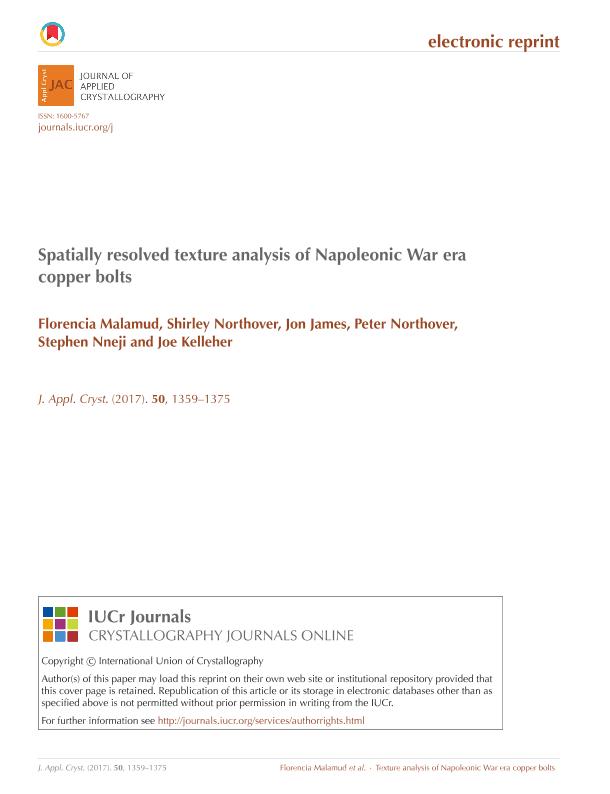Mostrar el registro sencillo del ítem
dc.contributor.author
Malamud, Florencia

dc.contributor.author
Northover, Shirley
dc.contributor.author
James, Jon
dc.contributor.author
Northover, Peter
dc.contributor.author
Nneji, Stephen
dc.contributor.author
Kelleher, Joe
dc.date.available
2018-01-09T22:10:27Z
dc.date.issued
2017-09
dc.identifier.citation
Kelleher, Joe; Nneji, Stephen; James, Jon; Malamud, Florencia; Northover, Shirley; Northover, Peter; et al.; Spatially resolved texture analysis of Napoleonic War era copper bolts; International Union of Crystallography; Journal Of Applied Crystallography; 50; 9-2017; 1359-1375
dc.identifier.issn
1600-5767
dc.identifier.uri
http://hdl.handle.net/11336/32768
dc.description.abstract
The spatial resolution achievable by a time-of-flight neutron strain scanner has been harnessed using a new data analysis methodology (NyRTex) to determine, nondestructively, the spatial variation of crystallographic texture in objects of cultural heritage. Previous studies on the crystallographic texture at the centre of three Napoleonic War era copper bolts, which demonstrated the value of this technique in differentiating between the different production processes of the different types of bolts, were extended to four copper bolts from the wrecks of HMS Impregnable (completed 1786), HMS Amethyst (1799), HMS Pomone (1805) and HMS Maeander (1840) along with a cylindrical `segment' of a further incomplete bolt from HMS Pomone. These included bolts with works stamps, allowing comparison with documentary accounts of the manufacturing processes used, and the results demonstrated unequivocally that bolts with a `Westwood and Collins' patent stamp were made using the Collins rather than the Westwood process. In some bolts there was a pronounced variation in texture across the cross section. In some cases this is consistent with what is known of the types of hot and cold working used, but the results from the latest study might also suggest that, even in the mature phase of this technology, some hand finishing was sometimes necessary. This examination of bolts from a wider range of dates is an important step in increasing our understanding of the introduction and evolution of copper fastenings in Royal Navy warships.
dc.format
application/pdf
dc.language.iso
eng
dc.publisher
International Union of Crystallography
dc.rights
info:eu-repo/semantics/openAccess
dc.rights.uri
https://creativecommons.org/licenses/by-nc-sa/2.5/ar/
dc.subject
Texture
dc.subject
Copper Bolt
dc.subject
Neutron Diffraction
dc.subject.classification
Física Atómica, Molecular y Química

dc.subject.classification
Ciencias Físicas

dc.subject.classification
CIENCIAS NATURALES Y EXACTAS

dc.title
Spatially resolved texture analysis of Napoleonic War era copper bolts
dc.type
info:eu-repo/semantics/article
dc.type
info:ar-repo/semantics/artículo
dc.type
info:eu-repo/semantics/publishedVersion
dc.date.updated
2017-12-15T14:32:24Z
dc.journal.number
50
dc.journal.pagination
1359-1375
dc.journal.pais
Reino Unido

dc.journal.ciudad
Londres
dc.description.fil
Fil: Malamud, Florencia. Comisión Nacional de Energía Atómica. Centro Atómico Bariloche; Argentina. Consejo Nacional de Investigaciones Científicas y Técnicas; Argentina
dc.description.fil
Fil: Northover, Shirley. The Open University; Reino Unido
dc.description.fil
Fil: James, Jon. The Open University; Reino Unido
dc.description.fil
Fil: Northover, Peter. The Open University; Reino Unido. Research Laboratory for Archaeology and the History of Art; Reino Unido
dc.description.fil
Fil: Nneji, Stephen. The Open University; Reino Unido. Rutherford Appleton Laboratory; Reino Unido
dc.description.fil
Fil: Kelleher, Joe. Rutherford Appleton Laboratory; Reino Unido
dc.journal.title
Journal Of Applied Crystallography

dc.relation.alternativeid
info:eu-repo/semantics/altIdentifier/doi/http://dx.doi.org/10.1107/S1600576717011761
dc.relation.alternativeid
info:eu-repo/semantics/altIdentifier/url/http://scripts.iucr.org/cgi-bin/paper?S1600576717011761
Archivos asociados
